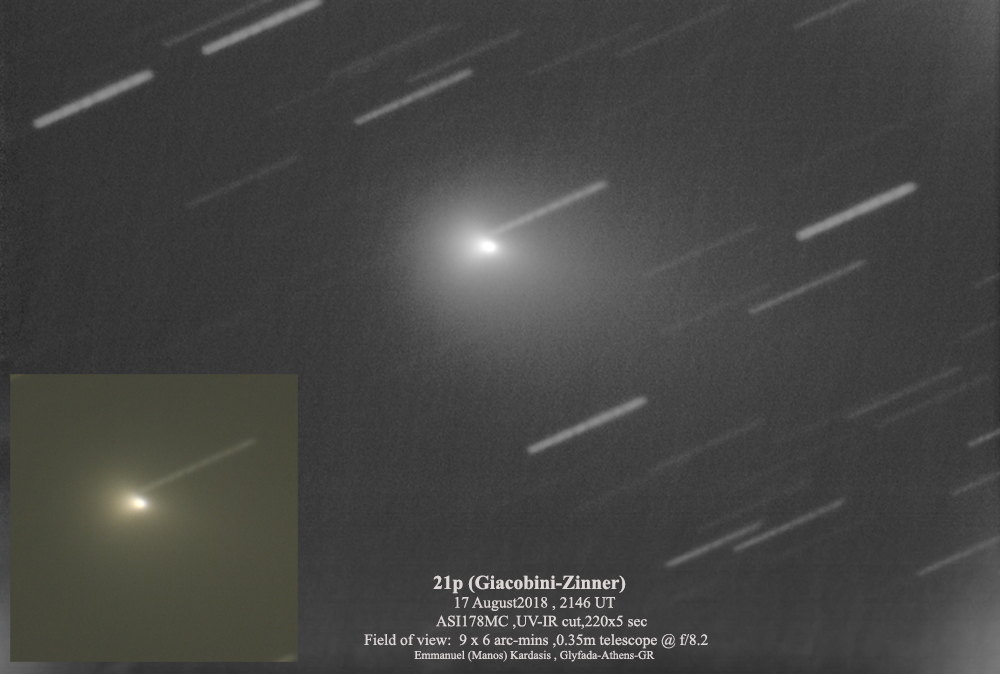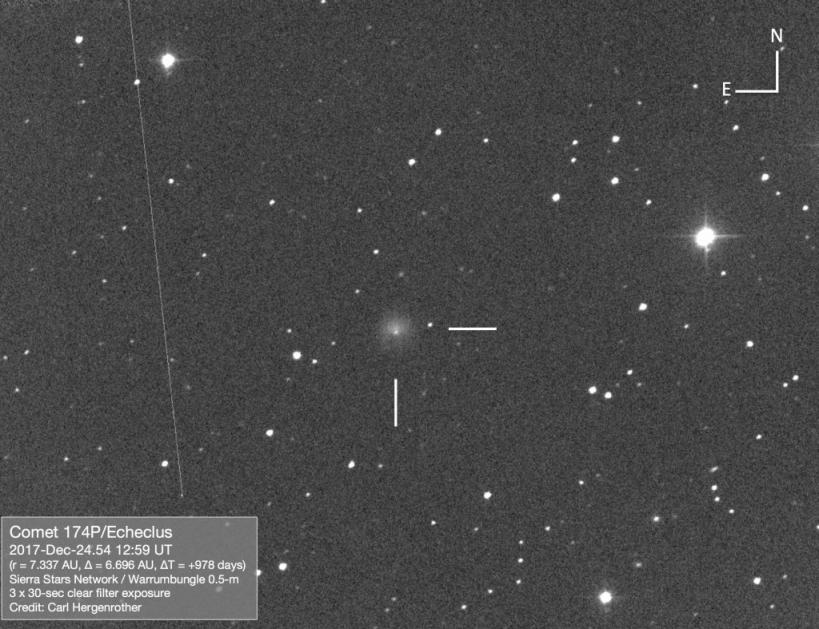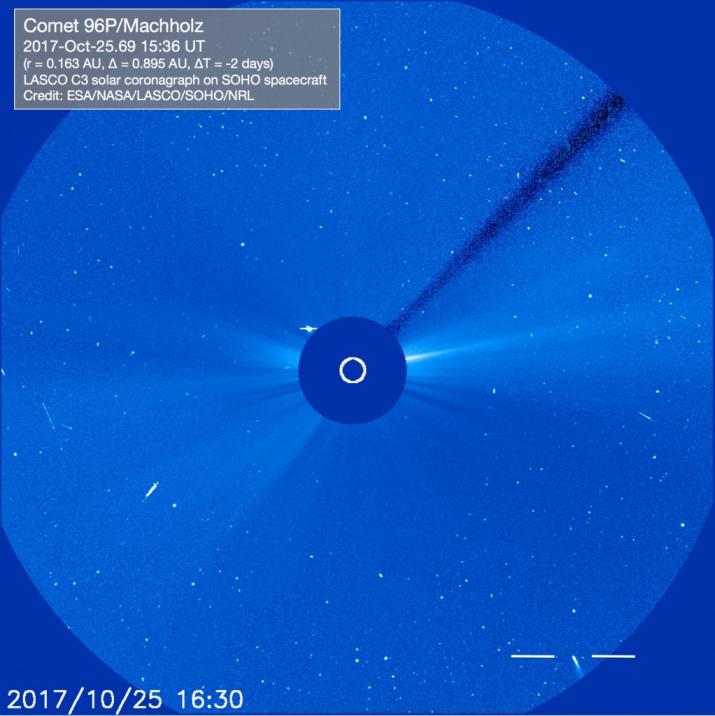ALPO COMET NEWS FOR SEPTEMBER 2018
2018-September-3
[Note from the Comet Section Coordinator: For the past few months I have been posting these monthly summaries on the CloudyNights forum. Each monthly ALPO Comet News has its own forum page for observers and comet enthusiasts to share observations. Please check it out and join in the fun if so inclined. Here's a direct link to the September 2018 page.
https://www.cloudynights.com/topic/631971-alpo-comet-news-for-september-2018/ ]
21P/Giacobini-Zinner will be the focus of most comet watchers this month as it peaks at 7th magnitude. Only C/2016 M1 (PANSTARRS) will be brighter than 10th magnitude though it is only in view for southern observers. This fall and winter will see a number of bright short-period comets come into view. CCD and large aperture visual observers will be able to watch 38P/Stephan-Oterma, 46P/Wirtanen and 64P/Swift-Gehrels brighten to around magnitude 11, 11 and 12, respectively. Each will brighten further over the next few months with Wirtanen reaching around 3rd magnitude (though it may be a relatively low surface brightness object).
Bright Comets (magnitude < 10)
21P/Giacobini-Zinner – Short-period comet 21P/Giacobini-Zinner will be this month’s brightest comet. With an orbital period of 6.5 years, 21P is making its 16th observed return since its visual discovery in 1900. This year 21P has an above average return as it will pass 0.39 AU of Earth on September 10 with perihelion also occurring on the that date. Only the returns in 1946 and 1959 were closer to Earth and not until 2078 will 21P be this close again.
Visual observations submitted to the ALPO over the last week or so show 21P to be between magnitude 7.4 and 7.6. This suggests the comet is running a little fainter than expected. Then again the Moon has been bright and/or nearby and possibly hiding the outer extent of 21P’s coma resulting in fainter estimates. Regardless, 21P should start the month close to its peak brightness with a sight fading of ~0.5 magnitudes or so by the end of the month.
With a path that is almost parallel to the Milky Way, 21P will continue to pass through some deep sky rich constellations [Auriga (Sep 1-13), Gemini (13-16,18-19,20-22), Orion (16-18,19-20) and Monoceros (22-31)]. The month starts with G-Z as a far northern object moving past the bright star Capella. It becomes an easier object for southern observers as the month progresses. Close approaches providing nice photo ops will occur on Sep 10th (open cluster M37), 15th (open cluster M35), 22nd through 24th (dark nebulae Barnard 37 and 38 and open cluster NGC 2264, the Christmas Tree Cluster), 26th and 27th (the Rosette Nebula and adjacent open clusters) and 30th (open cluster NGC 2301). Recent images by Chris Schur, Manos Kardasis and Charles Bell continue to show the sunward jet(s) or fan that was mentioned last month.
21P/Giacobini-Zinner
T = 2018-Sep-10 q = 1.01 AU Short-Period comet Period = 6.5 yr
Date Mag R.A. Decl. r d Elong const
2018- 9-01 7.1 05 00 +48 25 1.022 0.406 80M Aur
2018- 9-11 7.0 05 52 +32 06 1.013 0.391 79M Aur
2018- 9-21 7.1 06 27 +14 58 1.024 0.408 81M Gem
2018-10-01 7.6 06 51 +00 03 1.055 0.453 84M Mon
The image below is from Manos Kardasis and shows 21P and its sunward fan/jet on August 17.

C/2016 M1 (PANSTARRS) - Visual observations by Chris Wyatt on August 29 found the comet at magnitude 9.8 which is a little fainter than expected. Having passed perihelion on August 10 at 2.21 AU and now moving away from both the Earth and Sun, C/2016 M1 should continue to slowly fade as it moves through the southern reaches of Centaurus.
C/2016 M1 (PANSTARRS)
T = 2018-Aug-10 q = 2.21 AU Long-Period comet - dynamically old
Date Mag R.A. Decl. r d Elong const
2018-09-01 9.5 14 29 -58 16 2.225 2.144 81E Cen
2018-09-11 9.7 14 25 -59 11 2.241 2.297 74E Cen
2018-09-21 9.9 14 24 -60 23 2.263 2.438 68E Cen
2018-10-01 10.1 14 27 -61 51 2.290 2.564 62E Cen
Faint Comets (between magnitude 10 and 13)
38P/Stephan-Oterma – Comet Stephan-Oterma is returning for the first time since 1980. This comet has a bit of an interesting backstory. In 1867, it was first sighted by Jérôme E. Coggia (Marseilles, France) who thought he had found an uncatalogued nebula. Over the following nights, followup observations by E. J. M. Stephan (Marseilles, France) uncovered the true nature of the object. For some reason, the discovery announcement cited Stephan as the discoverer with no mention of Coggia. After being missed at its next return in 1904, the comet was photographically rediscovered in 1942 by Liisi Oterma (Turku, Finland).
This month, 38P will be a morning object in Orion as it brightens from 12th to 10th magnitude. Ultimately the comet will peak around magnitude 9.0 to 9.5 in late November after its perihelion on November 10 at 1.59 AU. In 1980, Stephan-Oterma approached to within 0.59 AU of Earth and brightened to between magnitude 8.5 and 9.0. This year’s return will be a little further away at 0.76 AU, hence the slightly fainter maximum brightness.
38P/Stephan-Oterma
T = 2018-Nov-10 q = 1.59 AU Short-Period comet Period = 38.0 yr
Date Mag R.A. Decl. r d Elong const
2018-09-01 12.5 04 43 +07 17 1.819 1.548 88M Ori
2018-09-11 11.9 05 07 +08 44 1.762 1.422 91M Ori
2018-09-21 11.4 05 31 +10 16 1.713 1.306 94M Ori
2018-10-01 10.8 05 55 +11 56 1.670 1.199 98M Ori
46P/Wirtanen – The brightest comet of the year should be 46P/Wirtanen which will pass within 0.08 AU of the Earth in mid-December. Wirtanen will be located around a southern declination of -30 degrees till late November (in the constellations of Cetus and Fornax). The comet will brighten from 14th to 11th magnitude this month.
By late November, it will begin to rapidly move northeastward across Eridanus, Aries, Taurus, Perseus, Auriga, Lynx and Ursa Major. Naked eye brightness should be attained by late November. A peak brightness around magnitude 3 occurs in mid-December. Note, that as a short-period comet, Wirtanen is likely to be a large diffuse object around the time of closest approach. It is possible its coma diameter will be in excess of 1 degree. Do not expect it to appear as bright as a 3rd magnitude star since it light will be spread over a large area. Observers may need a relatively dark sky to see Wirtanen with the naked eye.
46P/Wirtanen
T = 2018-Dec-12 q = 1.06 AU Short-Period comet Period = 5.4 yr
Date Mag R.A. Decl. r d Elong const
2018-09-01 14.2 01 31 -18 14 1.668 0.781 137M Cet
2018-09-11 13.2 01 41 -20 33 1.583 0.667 141M Cet
2018-09-21 12.3 01 48 -23 17 1.500 0.566 143M Cet
2018-10-01 11.3 01 53 -26 14 1.418 0.479 144M For
48P/Johnson – 48P/Johnson has a large perihelion distance for a relatively bright short-period comet. Perihelion (2.00 AU) and closest approach to Earth (1.01 AU) occur within a week of each other in mid-August making this as good a return as possible for 48P. This year marks its 11th observed return since it was discovered in 1949 by Ernest L. Johnson on photographs taken at the Union Observatory in Johannesburg, South Africa.
During August, most observers have been consistently placing this comet between magnitude 12 and 13 The only dissenter being J. J. Gonzalez who estimates a much brighter magnitude of 9.6 to 9.7. J. J. also is seeing a much larger coma (1-2’ vs 7’). It is possible that a very low surface brightness extended coma is being missed by some observers. Now past perihelion the comet should start to fade by ~0.7 magnitudes this month.
48P/Johnson
T = 2018-Aug-12 q = 2.00 AU Short-Period comet Period = 6.5 yr
Date Mag R.A. Decl. r d Elong const
2018-09-01 11.2 +22 35 -27 10 2.011 1.029 161E PsA
2018-09-11 11.4 +22 31 -28 16 2.019 1.064 154E PsA
2018-09-21 11.6 +22 28 -28 45 2.029 1.119 145E PsA
2018-10-01 11.9 +22 28 -28 39 2.043 1.191 137E PsA
64P/Swift-Gehrels – Comet Swift-Gehrels was originally discovered visually by Lewis Swift (Rochester, New York) in 1889. Swift was also the discoverer of the Perseid parent body, Swift-Tuttle. After the 1889 apparition Swift’s comet went unobserverd until 1973 when its was rediscovered by Tom Gehrels on photographic plates taken at Palomar Observatory in southern California. 2018 marks Swift-Gehrels’ 7th observed return. Since its discovery in 1889, the comet’s orbit has been fairly stable with an orbital period of 9.4 years and perihelion distance near its current value of 1.39 AU. Not an especially bright object, this year’s return will be its best known return with a minimum Earth-comet distance of 0.44 AU on October 28. You will have to wait till 2092 for another return as good as this year’s though the 2046 return will just a little worse.
64P has already shown some excitement with a short lived outburst that saw it brighten by ~2-3 magnitudes to around 13th magnitude in mid-August. Swift-Gehrels has since settled down again and, unless it outbursts again, should brighten from 15th to 12th magnitude this month. Peak brightness will be around magnitude 9.5 in late November.
64P/Swift-Gehrels
T = 2018-Nov-3 q = 1.39 AU Short-Period comet Period = 8.9 yr
Date Mag R.A. Decl. r d Elong const
2018-09-01 15.0 00 17 +20 28 1.586 0.663 142M Psc
2018-09-11 14.0 00 22 +24 20 1.534 0.590 146M Psc
2018-09-21 13.1 00 25 +28 05 1.489 0.533 149M Psc
2018-10-01 12.2 00 28 +31 27 1.452 0.491 151M And
The image below by Charles Bell shows 38P on August 15 during its recent outburst.
C/2016 R2 (PANSTARRS) – CO+ rich comet C/2016 R2 (PANSTARRS) continues its very slow fade. Thanks to its large perihelion distance (2.60 AU), the comet experiences slow changes in its heliocentric and geocentric distances. The comet should remain around 12th magnitude this month as it pulls sway from the Sun in the northern morning sky.
C/2016 R2 (PANSTARRS)
T = 2018-May-02 q = 2.60 AU Long-Period comet - dynamically old
Date Mag R.A. Decl. r d Elong const
2018-09-01 11.7 10 58 +50 43 2.869 3.532 42M UMa
2018-09-11 11.8 11 27 +49 40 2.914 3.538 44M UMa
2018-09-21 11.9 11 56 +48 29 2.962 3.544 47M UMa
2018-10-01 12.0 12 23 +47 14 3.012 3.552 50M CVn
C/2017 T3 (ATLAS) – The most recent observation by Chris Wyatt placed Comet ATLAS at magnitude 12.3 on August 29. This is a good magnitude or more fainter than it should be and significantly fainter than it was on August 14 (magnitude 10.2). It will be interesting to see if the comet is really fading fast (or if a bright Moon-lit sky is to blame). Now over a month past perihelion, C/2017 T3 (ATLAS) should be fading though now the question is how rapidly.
C/2017 T3 (ATLAS)
T = 2018-Jul-19 q = 0.83 AU Long-Period comet - dynamically old
Date Mag R.A. Decl. r d Elong const
2018-09-01 10.8 11 33 -30 51 1.151 1.696 41M Hya
2018-09-11 11.5 12 21 -30 25 1.276 1.899 38M Hya
2018-09-21 12.2 12 59 -29 30 1.406 2.114 34M Hya
2018-10-01 12.8 13 30 -28 28 1.539 2.328 29M Hya
C/2018 N1 (NEOWISE) - C/2018 N1 (NEOWISE) was discovered by NASA’s low-Earth orbiting NEOWISE spacecraft on July 2nd at 16th magnitude. Earth-based observers quickly determined that NEOWISE was much brighter. The comet continued to brighten as it approached perihelion on August 1 at 1.31 AU and closest to Earth on July 27 at 0.31 AU. Chris Wyatt and Juan Jose Gonzalez estimated it to be around magnitude 8.3 to 9.5 by the end of July. The comet is in full retreat from both the Sun and Earth and should continue to fade from 12th to near 14th magnitude as it recedes back into the outer solar system.
C/2018 N1 (NEOWISE)
T = 2018-Aug-01 q = 1.31 AU Long-Period comet - dynamically old
Date Mag R.A. Decl. r d Elong const
2018-09-01 12.2 15 12 -10 00 1.383 1.344 70E Lib
2018-09-11 12.8 15 07 -08 38 1.438 1.660 59E Lib
2018-09-21 13.3 15 06 -07 47 1.504 1.950 49E Lib
2018-10-01 13.7 15 07 -07 12 1.580 2.210 40E Lib
Other Comets of Interest
C/2017 S3 (PANSTARRS) – Last month we left C/2017 S3 (PANSTARRS) in a sad state. Being dynamically new and intrinsically faint, PANSTARRS was expected to disintegrate at some point either on approach to perihelion or not too long afterwards. After experiencing at least two outbursts on June 30/July 1 and July 15, the comet’s morphology and dust/gas production seemed to nosedive on the 20th. The last Earth-based images were taken on August 3rd and showed a diffuse object with no central condensation. As far as anyone could tell the comet’s nucleus had been severely disrupted.
No further Earth based observations were possible after the first few days of August because of the comet’s decreasing elongation from the Sun. Luckily, the comet did travel through the FOV of the Hi1 imager on the STEREO-A spacecraft between July 31 and August 14. Surprisingly the comet was still visible in the STEREO images on the 14th as it was leaving the FOV. For the entire period within the STEREO FOV, the comet appeared elongated and stretched along the direction of its orbit. Currently the comet is now moving through the FOV of the LASCO C3 instrument on the SOHO spacecraft. The SOHO C3 does not go as faint as the STEREO H1A and so far there has been no sign of the comet in that instrument. We will have to wait till sometime in mid to late October to see the comet again from Earth though it is highly unlikely that anything will remain to be seen of C/2017 S3.
(944) Hidalgo and (3552) Don Quixote – Two low activity or extinct comets come to perihelion this year. (3552) Don Quixote is still designated an asteroid even though a tail was seen in 2009 and again this March. This month Don Quixote is near magnitude 16.3. (944) Hidalgo is still inbound and will peak in brightness at 14.3 in November. Unlike Don Quixote, Hidalgo has shown no cometary activity so far.
364P/PANSTARRS – 364P/PANSTARRS is another low activity comet, but only shows activity at small heliocentric distances. Discovered in 2013, 364P is making its second observed return with perihelion having occurred in late June at 0.80 AU. Cometary activity should greatly decrease or even cease allowing CCD imagers the opportunity to directly image its bare nucleus this month at around 17th magnitude.
364P/PANSTARRS
T = 2018-Jun-24 q = 0.80 AU Short-Period comet Period = 4.9 yr
Date Mag R.A. Decl. r d Elong const
2018-09-01 16.5 01 32 -32 23 1.309 0.391 133M Scl
2018-09-11 16.7 00 52 -29 37 1.415 0.463 146M Scl
2018-09-21 17.0 00 22 -26 28 1.521 0.555 153M Scl
2018-10-01 17.6 00 02 -23 18 1.625 0.668 153E Cet
(944) Hidalgo
T = 2018-Oct-26 q = 1.95 AU Extinct comet Period = 13.8 yr
Date Mag R.A. Decl. r d Elong const
2018-09-01 15.0 04 53 +44 37 2.025 1.909 81M Aur
2018-09-11 14.9 05 18 +49 11 2.000 1.801 85M Aur
2018-09-21 14.7 05 46 +53 51 1.979 1.706 90M Aur
2018-10-01 14.6 06 18 +58 31 1.964 1.625 93M Lyn
(3552) Don Quixote
T = 2018-May-07 q = 1.24 AU Extinct comet Period = 8.8 yr
Date Mag R.A. Decl. r d Elong const
2018-09-01 16.3 03 01 +42 32 1.884 1.400 101M Per
2018-09-11 16.3 02 58 +46 20 1.967 1.392 109M Per
2018-09-21 16.3 02 49 +49 39 2.051 1.392 116M Per
2018-10-01 16.3 02 34 +52 15 2.134 1.405 124M Per
As always, the Comet Section is happy to receive all comet observations, whether images, drawings, magnitude estimates, and even spectra. Please send your observations via email to < carl.hergenrother @ alpo-astronomy.org >.
- Carl Hergenrother (ALPO Comet Section Coordinator)













